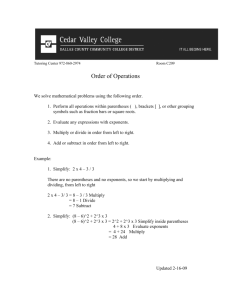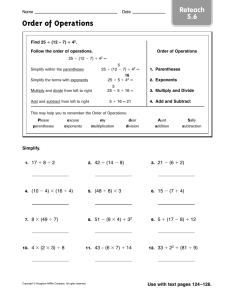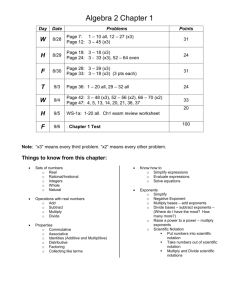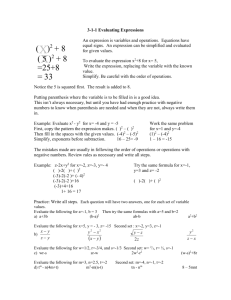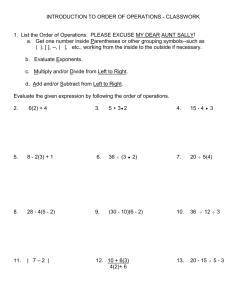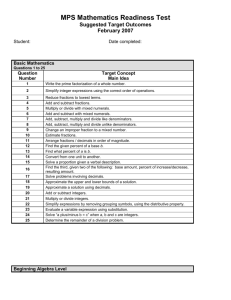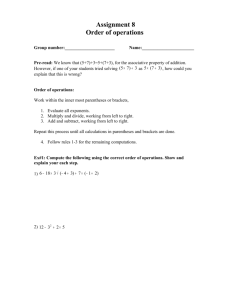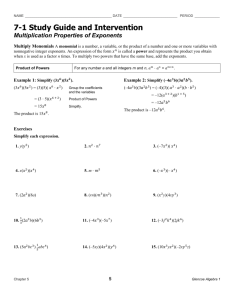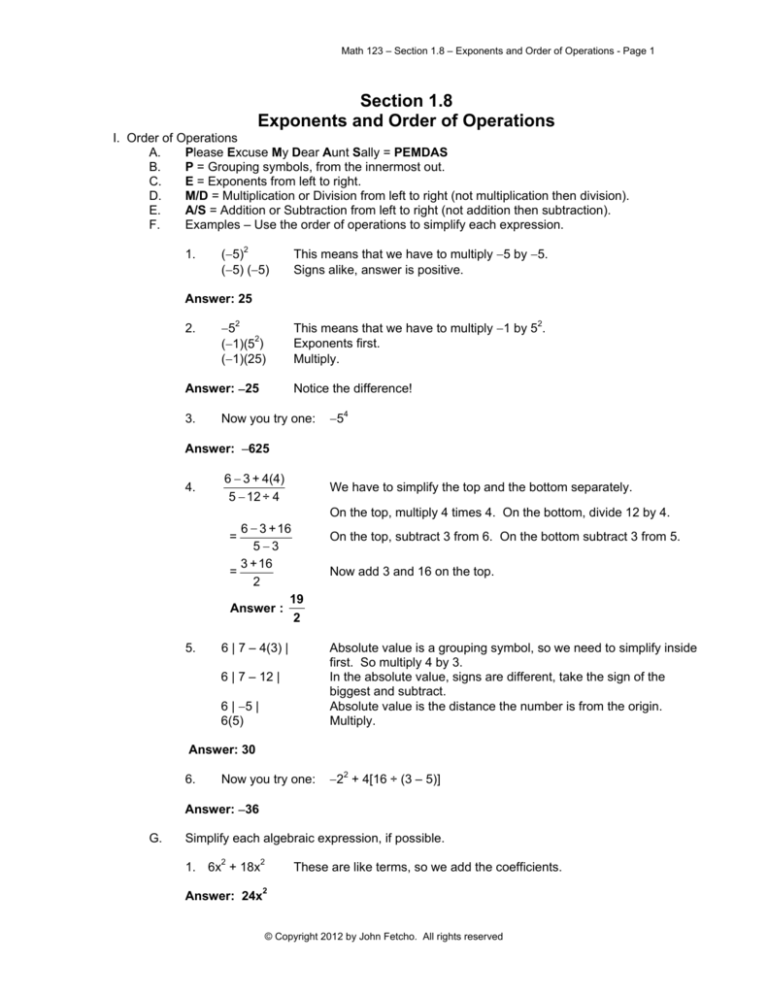
Math 123 – Section 1.8 – Exponents and Order of Operations - Page 1
Section 1.8
Exponents and Order of Operations
I. Order of Operations
A.
Please Excuse My Dear Aunt Sally = PEMDAS
B.
P = Grouping symbols, from the innermost out.
C.
E = Exponents from left to right.
D.
M/D = Multiplication or Division from left to right (not multiplication then division).
E.
A/S = Addition or Subtraction from left to right (not addition then subtraction).
F.
Examples – Use the order of operations to simplify each expression.
1.
(5)2
(5) (5)
This means that we have to multiply 5 by 5.
Signs alike, answer is positive.
Answer: 25
2.
52
(1)(52)
(1)(25)
Answer: 25
3.
This means that we have to multiply 1 by 52.
Exponents first.
Multiply.
Notice the difference!
Now you try one:
54
Answer: 625
4.
6 3 + 4(4)
5 12 ÷ 4
We have to simplify the top and the bottom separately.
On the top, multiply 4 times 4. On the bottom, divide 12 by 4.
6 3 +16
53
3 +16
=
2
19
Answer :
2
=
5.
6 | 7 – 4(3) |
On the top, subtract 3 from 6. On the bottom subtract 3 from 5.
Now add 3 and 16 on the top.
Absolute value is a grouping symbol, so we need to simplify inside
first. So multiply 4 by 3.
In the absolute value, signs are different, take the sign of the
biggest and subtract.
Absolute value is the distance the number is from the origin.
Multiply.
6 | 7 – 12 |
6 | 5 |
6(5)
Answer: 30
6.
Now you try one:
22 + 4[16 ÷ (3 – 5)]
Answer: 36
G.
Simplify each algebraic expression, if possible.
1. 6x2 + 18x2
These are like terms, so we add the coefficients.
Answer: 24x2
© Copyright 2012 by John Fetcho. All rights reserved
Math 123 – Section 1.8 – Exponents and Order of Operations - Page 2
2. 8x2 + 8x3
The exponents on the variables are different, these are not like terms.
Answer: Cannot be simplified.
3. Now you try one:
8x4 + x4
Answer: 9x4
4. 6 – 5[8 – (2y – 4)]
6 – 5[8 – 2y + 4]
6 – 5[12 – 2y]
6 – 60 + 10y
Simplify inside the grouping symbols first. 2y and 4 are not like
terms, but a negative in front of a parenthesis means multiply
everything in the parenthesis by 1.
In the brackets, add the 8 and the 4.
Distribute 5 into the brackets.
Combine the 6 and 60. Signs are different, take the sign of the
biggest and subtract.
Answer: 54 + 10y
5. Now you try one:
3[5(x 2) + 1]
Answer: 15x – 27
H.
Evaluate each algebraic expression for the given value of the variable.
1. x2 – 2x; x = 6
(6)2 – 2(6)
36 – 2(6)
36 – 12
Substitute 6 in for x in both spots.
Exponents first.
Multiply 2 and 6.
Subtract.
Answer: 24
2.
;y=5
Substitute 5 in for y in both the top and the bottom.
On the top, exponents first. On the bottom, simplify in the
parenthesis first.
On the top, multiply the 3 and 5 as well as the 2 and 25.
On the bottom, multiply the 5 and 3.
On the top, signs are different, take the sign of the biggest and
subtract.
Reduce. Signs are different, answer is negative.
Answer:
II.
Applications
A.
Process
1.
Read the problem.
2.
Determine what is unknown.
3.
Define a variable for the unknown.
4.
Write an equation expressing the problem algebraically (i.e. - translate from
English into Algebra).
5.
Solve the equation.
6.
Write a complete sentence answering the question.
© Copyright 2012 by John Fetcho. All rights reserved
Math 123 – Section 1.8 – Exponents and Order of Operations - Page 3
B.
Examples - Follow the 6-step process from above to answer each question.
1.
The bar graph (right-hand column, page 99) shows the estimated number of
calories per day needed to maintain energy balance for various gender and
age groups for sedentary lifestyles. The mathematical model
M = 96x2 + 802x + 660
Describes the number of calories needed per day, M, by males in age group x
with sedentary lifestyles. According to the model, how many calories per day
are needed by males between the ages of 19 and 30, inclusive, with this
lifestyle? Does this overestimate or underestimate the number shown by the
graph? By how much?
Since the 19 to 30 age group is group 4, we will let x = 4. Substituting 4 in for x in
the formula, we get:
M = .96(4)2 + 802(4) + 660
M = .96(16) + 802(4) + 660
M = 1,536 + 3,208 + 660
M = 2,332
Answer:
2.
Use PEMDAS to simplify, so exponents first.
Multiply next.
Now add.
Answer the question.
Males in the 19 to 30 age group need 2,332 calories. The formula
underestimates the bar graph by 68 calories.
In Palo Alto, CA, a government agency ordered computer-related companies to
contribute to a pool of money to clean up underground water supplies. (The
companies had stored toxic chemicals in leaking underground containers.) The
mathematical model
C=
200x
100 x
describes the cost, C, in tens of thousands of dollars, for removing x percent of the
contaminants. Use this formula to solve exercise 102 on page 100.
a.
Find the cost, in tens of thousands of dollars, for removing 60% of the contaminants.
Since x represents the percent of contaminants removed, we will substitute 50 in for x.
C=
C=
200(60)
100 60
12,000
40
Multiply numerator; subtract denominator.
Divide and answer the question.
Answer: It will cost $300 ten of thousands (or $3 million) to remove 60% of the
contaminants.
© Copyright 2012 by John Fetcho. All rights reserved
Math 123 – Section 1.8 – Exponents and Order of Operations - Page 4
b.
Now you try one: #102b Find the cost, in tens of thousands of dollars, for
removing 90% of the contaminants.
Answer: It will cost $1,800 tens of thousands (or $18 million) to remove 90% of the
contaminants.
c.
Describe what is happening to the cost of the cleanup as the percentage of
contaminant removed increases.
Answer: As the percentage increases, so does the cost.
© Copyright 2012 by John Fetcho. All rights reserved

